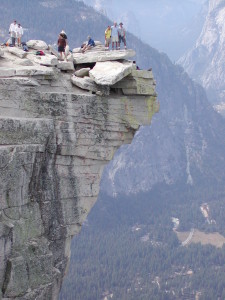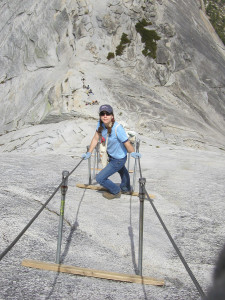The First Boulder is the Hardest
Two of the conditions I treat (using CBT — Cognitive Behavioral Therapy — and skills from DBT — Dialectical Behavior Therapy) are TINNITUS and MISOPHONIA. There are reportedly 50 million people in the US with tinnitus (ringing or other sounds in the ears, generated by the brain and not heard by others). There are probably many, many thousands of people with the less-recognized misophonia (extreme sensitivity and EXTREME reactivity to ordinary sounds, such as chewing, swallowing, breathing, or other human or sometimes mechanical sounds, and sometimes also reactions to repetitive visuals, such as hair twirling or foot jiggling). I have found that the first necessary steps to effective treatment are like giant boulders at the base of Half Dome in Yosemite.
I was going to say “the first STEP,” but that sounds like a different path than I have in mind, so I am calling them “boulders.” Let me back up …
Many years ago, I did a backpack trip to Yosemite, to climb the famous Half Dome. The climb up that steep, sheer rock face is well documented in thousands of photos: you don leather-palmed gloves, hold onto the metal cables on each side, and haul yourself up, step by difficult step, until at last you reach the top. Your friends above or below you on the cables take your picture, and you all collapse at the plateau, raise your fists in triumph, and take more photos of you and your crew standing on the edge overlooking the valley below.

What very few pictures show is the bottom of Half Dome trail, the part you have to climb before getting to the cables. It is a challenging hike … and that is where the First Boulder/Step comes in.
Before you get to the base of Half Dome, where cables are installed to help you make the climb, there are some large rock steps, not easy code-measurement stairs, but HUGE elevations. You have to get yourself up those rocks before you get to the cables.
So why am I going on about climbing a mountain in Yosemite?
If you have a big problem — like a chronic medical condition — before you can effectively deal with it, I have come to believe there are two huge steps to take. FIRST, you have to acknowledge/accept that you have this problem and it does not seem like it is going away, at least not likely in the near future. And SECOND, you have to get past, or set aside, your fury at that apparent reality, so you can actually start to deal with the problem.
That first step, acceptance, is actually very like The First Step in a 12-Step addiction program, which essentially acknowledges that “I have this problem.” Acknowledging or accepting that is NOT the same as giving up or giving in. But it IS a willingness to say “apparently, I am powerless with this problem’s existence.” NOT that I am powerless to do anything about it, but first I have to recognize this thing is real, and no matter how I feel about it, it doesn’t seem like it is going away.
Which brings us to the second step or boulder: getting past or setting aside the anger, rage, or fury at what seems to be a fact. I have this problem, it is MY problem, not everyone else’s, and I have to figure out what to do about it … even though it does not seem fair, and even though I would like to make everyone else fix their behavior so I don’t have to deal with this, and even though I want it to JUST STOP!
Some of the things that create that anger about having this problem, concerns that I have heard many times, are these:
For tinnitus: if only I had not gone to so many loud rock concerts … if only I had used ear plugs … if only I had paid better attention and not gotten into that accident … if my family would just be quieter … if only they would understand how hard this is for me …
For misophonia: will you just stop chewing gum? Will you just stop chewing with your mouth open? Why can’t you breathe more quietly? Stop sniffling! Get a tissue! Do you have to clear your throat or cough? Why can’t you eat without the spoon clanking against the bowl? If you would just stop it, I’d be fine!
Accepting that this problem exists (DANG IT ANYWAY), and then accepting that anger is not helping to make it go away are those first two big boulders. Once you have climbed them, then you are close enough to the cables on the steep mountainside, so you can grab onto the tools being offered (sound generators, earplugs, CBT, Neurofeedback, etc.) and make good use of them. If you have not yet conquered those first two steps, the cables will slip out of your grasp and be next to useless for you.
So where are you on the trail?





over the 2 boulders – reaching for the tools
Thank you for that comment, Paula. Hope you have found some tools …
Oh my gosh… This is an awesome analogy! I can’t wait to read more! Saving this gem in my Misophonia file!!Thank you for all you are doing!
Debi
Thank you for saying that, Debi. I appreciate it!
This was a very helpful analogy and one I would NEVER have come up with on my own…and I think that taking this approach will help me! Thank You
Thank you, Andrea. Glad this might be helpful to you!
This is great! So true! I have gone over those two boulders! Do you know of anyone with the right tools in Casper, WY that could help me?? Thank you for all you do to help with this condition!!!
Brittany
I don’t know of anyone with my particular set of tools in WY … BUT several misophonia people have gone to great lengths to get there to work with Scott Sessions. If online info is correct, he is in Thayne, WY, 307-883-4000. He is also on some of the Facebook misophonia pages, so you can check him out there. Best wishes!
Great analogy indeed! I’d like to add that I think there is another Boulder that wasn’t mentioned in this post. The Grieving Boulder. Until I started to grieve the loss of my pre-miso dreams and self-identity, acceptance was very difficult. My personal experience has been one of repeatiedly climbing the Boulder of Acceptance, then the Boulder of Greiving, over and over again, sometimes climbing with ease and other times stuck at the bottom of one of the boulders.
I think we need to keep in mind that this condition has many facets and to “over” simplify can neglect some very key areas. I don’t know how it fits, but I feel like there is more hope when compassion for ourself and others is part of the solution
Hello Dave, Thank you for this comment. I totally agree and actually wrote a post about this topic a while back. See what you think. http://www.sensitivetosound.com/2014/05/05/grieving-the-loss-of-the-life-you-expected/